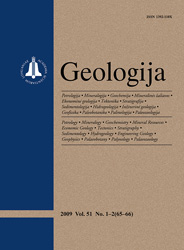 ISSN 1392-110X ISSN 2029-056X (online) |
2006 m. Nr. 3 Main stages of natural environmental changes in Lithuania during the Late Glacial and Holocene
The main significant stages of development of vegetation,
climate and soils, as well as other palaeogeographical conditions during the
Late Glacial and Holocene have been distinguished and are discussed in the paper.
The data used in this work have been obtained from investigations of pollen and
diatoms in lake and bog sediments, including those of the old Baltic Sea stages
in the western part of Lithuania. Six types of pollen diagrams are
distinguished for the Late Glacial and Holocene in Lithuania, and the net-like
method suggested earlier by the author (Кабайлене, 1969) is used to obtain a
reconstruction of the different stages of forest history. Keywords: environment, vegetation, climate, soils, lakes, peatbogs, pollen, diatoms, Lithuania |
Issues:
2011 - Vol.53 No. 1, No. 2, No. 3 2010 - Vol.52 No. 1-4 2009 - Vol.51 No. 1-2, No. 3-4 2008 - Vol.50 No. 1, No. 2, No. 3, No. 4, No. Priedas 2007 No. 1, No. 2, No. 3, No. 4 2006 No. 1, No. 2, No. 3, No. 4 2005 No. 1, No. 2, No. 3, No. 4 2004 No. 1, No. 2, No. 3, No. 4 2003 No. 1, No. 2, No. 3, No. 4 2002 No. 1, No. 2, No. 3, No. 4 2001 No. 1, No. 2, No. 3, No. 4 |